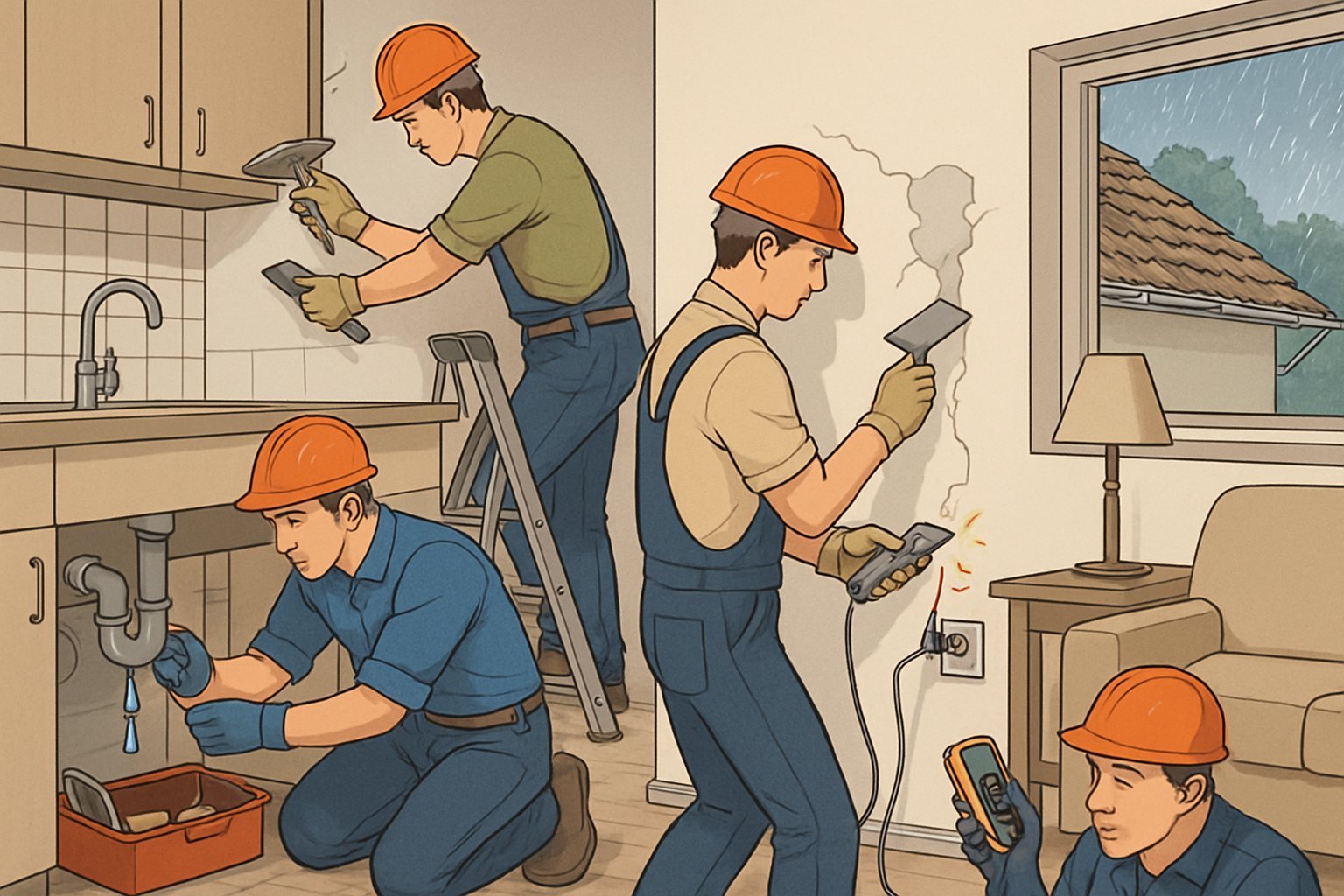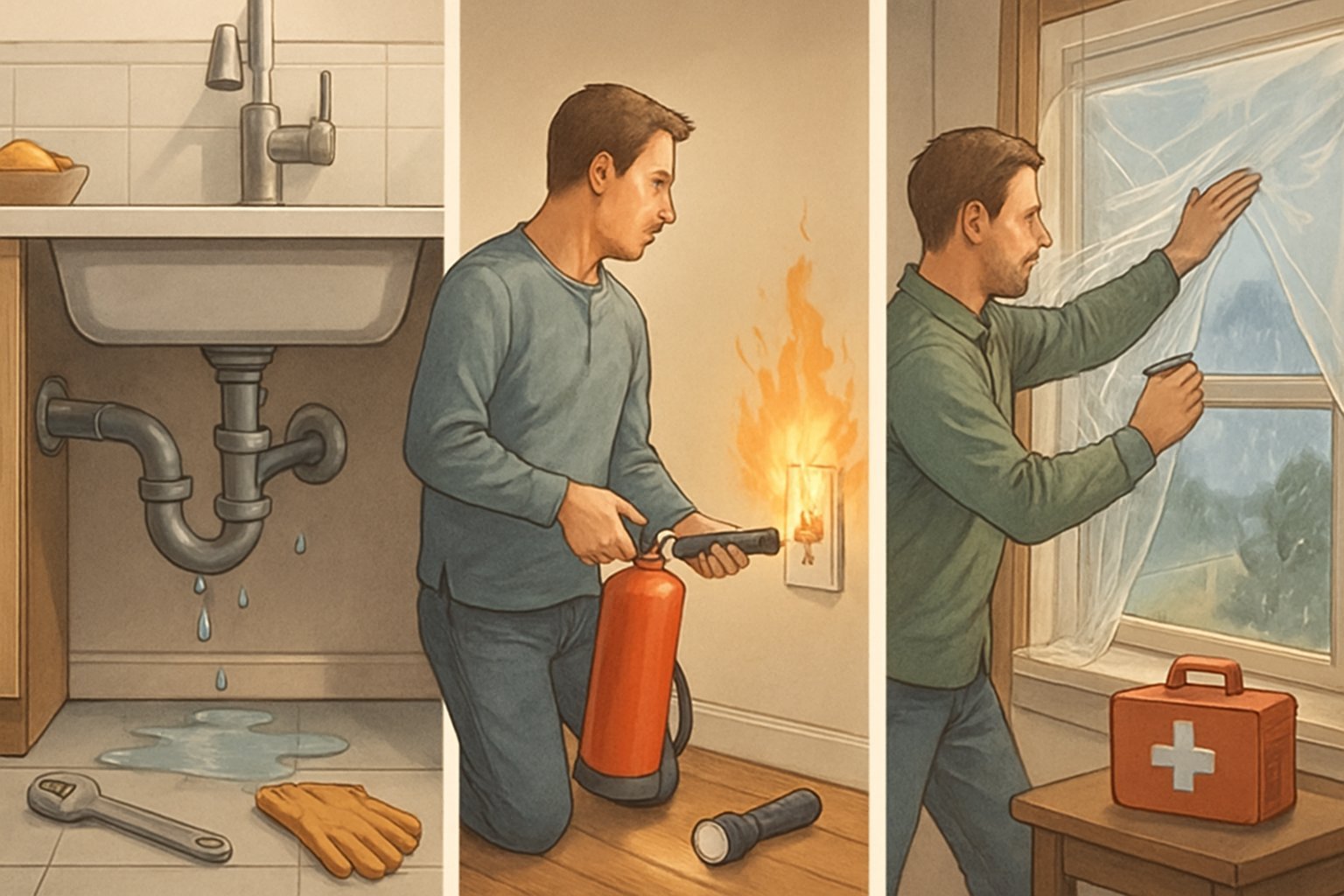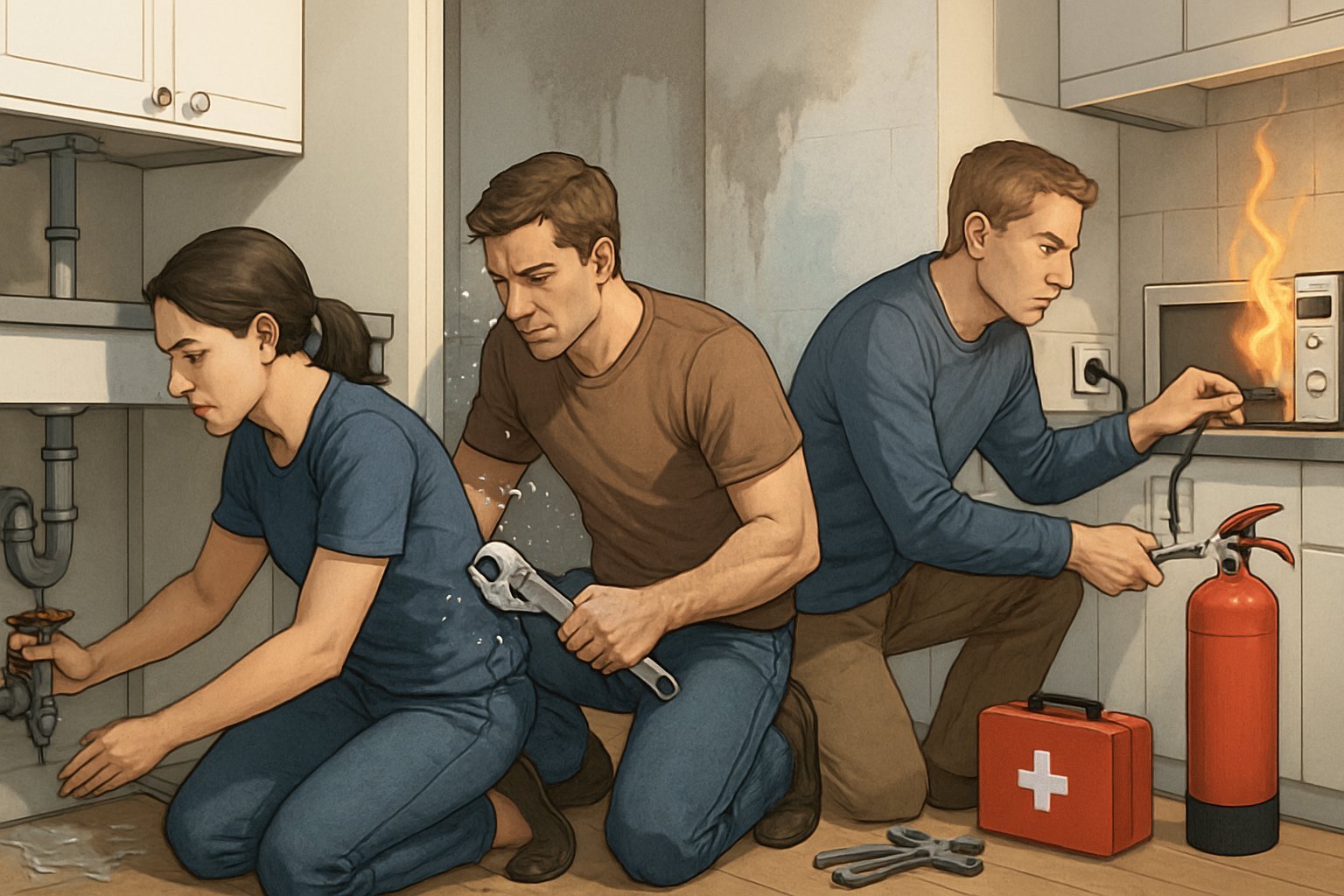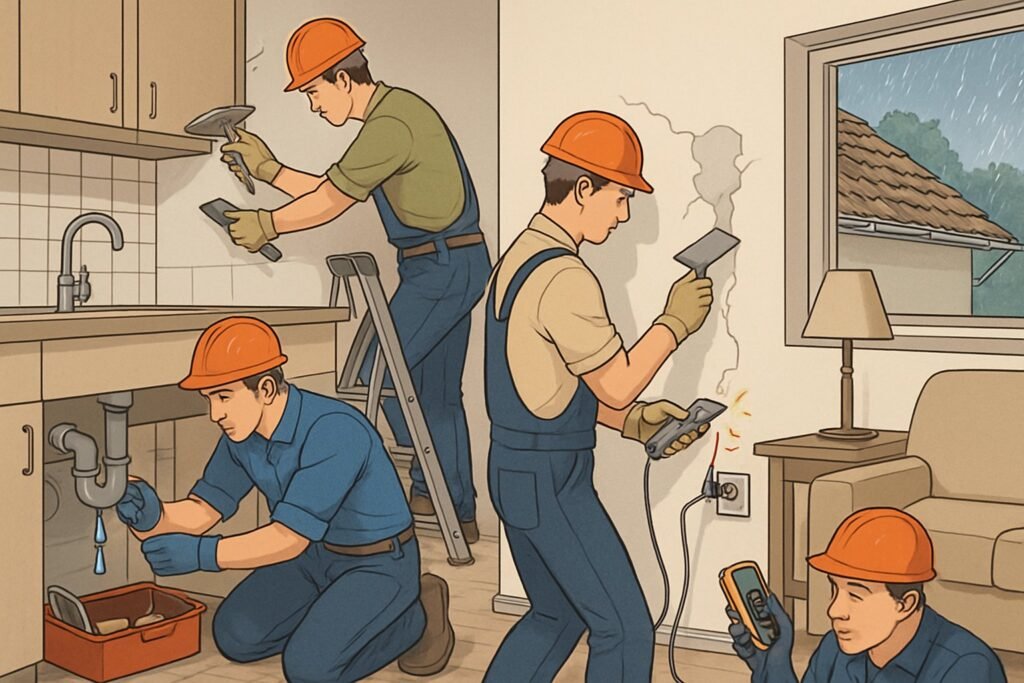Home emergencies hit out of nowhere, and if you don’t act fast, things can spiral. A burst pipe flooding the basement, a grease fire in the kitchen, or a power outage during winter—suddenly, your day is upside down.
What you do in those first few minutes? That can make the difference between a minor headache and a wallet-draining disaster.

Most people feel totally overwhelmed the first time something major goes wrong at home. Should you grab a wrench or get on the phone with a pro?
It really depends on what you’re dealing with and how bad it is. Some stuff, like a toilet that won’t stop running or a small leak, you can probably handle. But with electrical issues or gas leaks? Don’t risk it—call someone who knows what they’re doing.
If you understand the most common emergencies and have a rough plan, things get a lot less scary. Knowing how to shut off the water, reset breakers, or just do a quick patch job can buy you precious time while you’re waiting for help.
Key Takeaways
- Acting fast in a home emergency can save you a ton of money and stress.
- Knowing how to shut off water and electricity is crucial for stopping damage.
- Having basic supplies and a list of emergency contacts on hand makes everything easier when things go sideways.
How to Identify a Home Emergency Situation

Spotting the line between a regular problem and a true emergency can save you thousands and keep your family safe. Catching the warning signs early is everything.
Some situations need a fix right now—others can wait until morning. But which is which?
Recognizing Urgent Repair Needs
Water emergencies are at the top of the list. If you see active leaks from pipes, water heaters, or ceilings, you need to act fast or risk serious damage.
Critical water emergencies include:
- Burst pipes with water gushing out
- Ceilings that drip or sag
- Water heater leaks making puddles
- Toilets that keep overflowing
Electrical problems can get dangerous quickly. If an outlet sparks, you smell something burning from a panel, or lights start flickering everywhere, don’t wait.
Fire issues, like grease fires or an oven that won’t stop smoking, demand immediate action. Flames? Don’t hesitate.
If you smell gas inside or hear a hissing near an appliance, that’s a huge red flag. Get out and get help.
Structural issues—think sagging ceilings, big wall cracks, or doors that suddenly won’t close—can mean urgent repairs, too.
Assessing the Severity of the Problem
First, check if the problem messes with your home’s basic systems. No heat in winter, no hot water, or a total blackout? That’s serious.
How fast is the problem spreading? If water is running everywhere, stains are growing, or things are getting worse by the hour, you can’t wait.
Ask yourself:
- Is this getting bigger?
- Is anyone’s safety at risk?
- Will waiting make it worse?
- Is something essential not working?
Weather matters, too. A tiny roof leak is urgent if it’s pouring rain. Broken heat is a much bigger deal in January than in July.
If more than one room or floor has the problem, it’s probably not minor. Take pictures of the damage—insurance will thank you later.
Determining Safety Risks
If there’s any physical danger, get out and call for help. Gas leaks, electrical fires, or anything collapsing? Don’t try to be a hero.
High-risk situations:
- Exposed wires
- Gas smell indoors
- Carbon monoxide alarms going off
- Water pooling by outlets
- Parts of the building falling or shifting
Stuff like mold, chemical spills, or sewage backups can also make your home unsafe. Breathing issues? That’s an emergency.
If something blocks your exits, or you can’t leave safely, fix that first. No heat in a blizzard, dirty water, or a pest problem that spreads disease—these all put your family at risk.
Think about anyone vulnerable at home. For kids, elderly, or people with health issues, even small problems can get serious fast.
When to Call for Professional Help
Call the pros right away for gas leaks, electrical fires, or big structural damage. Some things just aren’t worth risking.
Don’t DIY these:
- Electrical problems you can’t fix with a breaker reset
- Anything involving gas lines or leaks
- Major plumbing disasters like sewer backups
- Damage to walls, ceilings, or the foundation
- Heating or cooling failures during extreme weather
Be honest about your skills. Emergency repairs often need tools and know-how most of us don’t have.
After-hours calls cost more, but sometimes you can’t wait. Check your insurance policy—some cover emergency repairs if you act fast.
Even in a rush, try to find licensed, insured contractors. It’s tempting to go with the first person who answers, but you don’t want to create bigger problems or get scammed.
Immediate Actions to Take During a Home Emergency

When disaster hits, those first moments really count. Moving fast to keep people safe, shut off utilities, and call for help can mean the difference between a quick fix and a nightmare.
Securing the Area and Ensuring Safety
Safety always comes first. Get everyone—including pets—away from the danger as soon as possible.
Move people out of flooded rooms, away from fire, or clear of any area with a gas leak or structural problem. Double-check that everyone is out.
Block off dangerous zones with whatever you have—chairs, rope, even tape. This keeps curious kids (and adults) from wandering back in.
Turn on lights if you can, or grab flashlights. Seeing hazards like broken glass or water on the floor helps you avoid more trouble.
Check for injuries right away. If someone is hurt, basic first aid can help until medics arrive.
If it’s safe, take photos or videos of the damage. You’ll need them for insurance, but don’t risk it if the area isn’t safe.
Turning Off Utilities
Shutting off utilities can stop a bad situation from getting worse. Water, electricity, and gas—know how to turn them off.
Find the main water valve (usually by the street or where the line enters the house) and turn it clockwise to stop flooding.
For electrical issues, flip the main breaker. Never touch the panel if you’re standing in water or your hands are wet.
If you smell gas, use a wrench to turn off the main valve outside. Turn it a quarter turn until it’s perpendicular to the pipe.
Take a few minutes before anything happens to find all your shutoffs. Mark them with bright tape so anyone can find them in a pinch.
Communicating with Emergency Services
Getting help quickly can really save the day. Don’t wait if things are dangerous.
Call 911 for fire, gas leaks, electrical hazards, or serious injuries. Give your address first, then describe what’s happening.
Let your utility companies know if you had to shut something off or if their equipment is damaged. They can help keep things safe and avoid bigger outages.
Reach out to family, friends, or neighbors if you need a place to stay or a hand with something urgent.
Keep track of who you called and when. Write down any reference numbers for insurance or repairs.
The Red Cross has tips for emergency communication and can help you find local shelters if things get really bad.
Water Damage and Plumbing Emergencies
Water damage sneaks up from burst pipes, old plumbing, or storms and floods. If you move quickly, you can save money and avoid gross stuff like mold.
Common Causes of Water Damage
Most water disasters start with plumbing failures. Pipes burst when it gets cold or if the pressure spikes.
Old pipes just give out after a while, leading to leaks behind walls or under your feet. Not fun.
Appliances can be troublemakers, too. Water heaters sometimes spring leaks or even burst, and washing machines can overflow if a hose pops off.
Weather doesn’t help. Heavy rain can flood basements, ice dams cause roof leaks, and hurricanes create massive messes.
Poor drainage outside lets water sneak into foundations. Clogged gutters? They’ll overflow and wreck your walls.
The Red Cross says millions of homes deal with water damage every year. Most problems start small, but ignoring them makes things way worse.
What to Do About Burst Pipes
First thing—shut off the main water supply. Usually, the valve is right where water comes into your house.
If water is near outlets, turn off the electricity in that area at the breaker. Water and electricity are a bad mix.
Open all your faucets to drain the pipes. Start with cold taps, then move to hot water.
Get rid of standing water fast. Use buckets, towels, or a wet vac—whatever works to keep water from soaking in and causing more damage.
Snap some pictures of the mess before you start cleaning. Insurance companies love documentation.
Tackling Leaks and Flooding
Deal with small leaks before they turn into disasters. Wrap leaky pipes with plumber’s tape for now, and stick a bucket underneath to catch drips.
If you’re dealing with serious flooding, move your stuff to dry ground. Open windows and set up fans to help things dry out.
For major water damage, call the pros. They have equipment to dry things out and stop mold from taking over.
Being prepared helps a lot. Keep a home emergency kit with flashlights, tools, and tarps, and know where your water shut-offs are.
Safety first, always. Never go into a flooded area if there’s any chance of electrical hazards. If you’re cleaning up nasty water, wear gloves and boots.
Roof and Structural Repairs
Storms can wreck a roof in no time. Foundation problems, on the other hand, sneak up over the years.
If you act fast, you can stop water from ruining your home and keep your family safe.
Handling Storm and Wind Damage
First things first: make sure everyone’s safe after a storm. Don’t rush into damaged areas—take a breath and check for hazards.
High winds rip shingles away and hurl debris at your roof. Hail smashes shingles and lets water creep inside.
Heavy rain? It’ll find any weak spot you missed.
Check for these warning signs:
- Missing or broken shingles
- Dents in gutters or flashing
- Water stains on ceilings
- Exposed roof decking
If you can do it safely, cover up damaged spots with tarps or plastic. That’ll keep more water out until help arrives.
Snap photos of everything before you start patching. Insurance folks want proof before they pay up.
Call a roofer right away if the damage looks serious. Don’t wait—water gets in fast and makes things worse.
The Red Cross says you should prep an emergency kit before storm season. It’s just smart to be ready for the unexpected.
Dealing with Collapsed Roofs
If the roof caves in, get out. Don’t even think about going back inside.
Never enter a building with roof collapse. The rest could come down without warning.
Signs of roof collapse risk:
- Sagging ceiling areas
- Cracks in walls or ceilings
- Doors that won’t close properly
- Creaking or popping sounds
Snow, ice dams, and old or neglected roofs cause most collapses. Poor upkeep only makes it worse.
Call 911 first. Then, let your insurance company know.
Only a pro engineer can say if it’s safe to go back in.
Natural disasters like hurricanes or tornadoes can wreck a roof in seconds. Make sure your family has a way out if things get bad.
Detecting Foundation Problems
Foundation trouble can mess up your whole house. Tiny cracks might not seem like much, but they can turn into a nightmare if you ignore them.
Watch for these foundation warning signs:
- Cracks in basement walls
- Doors and windows that stick
- Uneven or sloping floors
- Gaps around door frames
Water usually causes these problems. Bad drainage, leaks, and heavy rain all eat away at your foundation over time.
Act quickly when you spot foundation issues:
- Fix water problems first
- Keep an eye on cracks to see if they grow
- Call a structural engineer if you see big cracks
New homes get hairline cracks sometimes. But if a crack is wider than a quarter-inch, call in a pro.
Foundation fixes cost a lot. Catching things early saves cash and headaches.
Power, Heating, and Appliance Failures
When the power’s out or something big breaks, you’ve got to act fast. That’s how you avoid bigger problems and keep your family safe.
Most outages need a quick check, while heating or water heater issues call for a few specific steps.
Responding to Electrical Outages
Look around—do your neighbors have power? That’ll tell you if it’s just you or the whole block.
Use your phone flashlight so you don’t trip over anything in the dark.
If only your home lost power:
- Check the main breaker panel for tripped circuits
- Flip tripped breakers all the way off, then back on
- Plug something simple in, like a phone charger, to test outlets
If the whole neighborhood lost power:
- Call your power company and report it
- Keep fridge and freezer doors closed to save your food
- Turn off big appliances so they don’t get fried when the power comes back
Keep a home emergency kit with flashlights, batteries, and a radio. Never use a generator, grill, or camp stove inside—carbon monoxide is deadly.
Unplug electronics and appliances during blackouts. Power surges can wreck your TV or computer when the lights come back on.
Addressing Furnace and Boiler Breakdowns
Shut off the furnace or boiler at the main switch if you notice a problem. Check the thermostat batteries—they die more often than you’d think.
Common quick fixes:
- Swap out dirty air filters
- Make sure gas valves are open
- Look for error codes on digital displays
If you smell gas, get everyone out and call the gas company from outside. Don’t risk it.
On older gas systems, check if the pilot light’s out. If it is, follow the instructions to relight it—or call a pro if you’re unsure. Newer systems usually have electronic ignition.
Emergency heating alternatives:
- Close off rooms you’re not using
- Only run space heaters in rooms you’re in
- Never use ovens or stovetops for heat
Call a heating expert for anything beyond the basics. Frozen pipes can sneak up fast if your heat goes out in winter.
Managing Water Heater Malfunctions
For electric water heaters, cut the power at the breaker. For gas, turn the gas valve to “off.”
Check the pressure relief valve first. If it drips, the tank might just have high pressure—not a real leak.
For actual leaks:
- Shut off the main water supply
- Drain the tank using the valve at the bottom
- Stick a bucket under leaks to save your floors
No hot water? Try these:
- Check the pilot light on gas heaters
- Reset the temp switch on electric models
- Test the water temp at the nearest faucet
Most water heater problems need a pro. Tanks last 8-12 years, give or take, before you have to replace them.
If you hear weird noises, smell something burning, or see rust-colored water, don’t ignore it. Those usually mean trouble is coming fast.
Preparing Your Home for Future Emergencies
Planning ahead beats panicking later. The right supplies, a solid plan, and knowing your local risks make all the difference.
Building a Comprehensive Home Emergency Kit
Every home should have basic supplies in a spot you won’t forget. You’ll want enough to last everyone at least three days.
Water and food—aim for a gallon per person per day. Canned stuff, energy bars, dried fruit, plus a can opener and some paper plates.
Power and communication—battery radios, flashlights, and extra batteries. A portable charger for your phone is a lifesaver when the power’s out.
Medical and safety—first aid kit, pain meds, bandages, and any prescriptions you need. Toss in blankets, warm clothes, and sturdy shoes.
Tools and repair—duct tape, plastic sheeting, wrenches for gas shut-off, and basic tools. Keep some small bills on hand; ATMs might not work.
Developing an Emergency Preparedness Plan
Everyone in the family should know what to do before something happens. A written plan keeps things straight when stress is high.
Communication plans—decide how you’ll reach each other. Pick an out-of-state contact to help relay messages. Save key numbers in your phone and write them down too.
Evacuation routes—map out a few ways out of your house and neighborhood. Practice them, and pick meeting spots ahead of time. Keep your gas tank at least half full—just in case.
Utility shut-offs—know where your gas, water, and electric shut-offs are. Keep tools close by and make sure all adults know how to use them.
Important documents—store copies of insurance, IDs, and medical records in something waterproof. You’ll want them if you have to leave in a hurry.
Understanding Risks from Natural Disasters
Every area faces its own set of disasters. Local emergency offices can tell you exactly what to watch for.
Flood zones—get a sump pump, sandbags, and keep valuables up high. Know your flood risk and what your insurance really covers. Don’t store stuff right on the basement floor.
Earthquake country—anchor your furniture and use flexible connections on utilities. Keep heavy things low and a shut-off tool near your gas meter.
Hurricane zones—board up windows, check your generator, and trim dead branches. Label plywood for each window so you’re not scrambling when a storm’s coming.
Wildfire areas—clear out flammable plants within 30 feet of your house. Pack a go-bag and make sure your hose can reach all sides of your home.
Frequently Asked Questions
Emergencies at home can be overwhelming. It’s tough to know when to act fast, what counts as a true emergency, or where to find help.
What steps should I take first in case of a home emergency repair situation?
First, make sure everyone’s safe. If there’s fire, gas, or electrical danger, get out and call for help.
For water problems, shut off the main valve—usually in the basement or near the front of the house.
Take photos before you start patching things up. Insurance companies want evidence for claims.
Call your insurance company as soon as you can. Many policies require you to notify them right away.
How can I identify if a home repair issue qualifies as an emergency?
Emergency repairs threaten safety, health, or property right now. These problems get worse quickly and can cause serious damage.
Hazards like exposed wires, gas leaks, or structural trouble need a pro’s attention immediately. Don’t wait.
Water emergencies—burst pipes or big leaks—can cause thousands in damage fast. Move quickly to avoid mold and bigger headaches.
If a break-in leaves doors or windows busted, fix them right away. Otherwise, your home stays wide open to weather or intruders.
What are some examples of urgent home repair issues that require immediate attention?
Burst or broken pipes are right at the top of the list. Water damage can spread so fast—floors, walls, your stuff, all ruined in hours if you don’t act.
Grease fires in the kitchen? That’s another emergency you can’t ignore. Never pour water on them—throw a metal lid over the flames or dump on baking soda instead.
Overflowing toilets can flood the whole bathroom with contaminated water. Shut off the valve behind the toilet right away and mop up the mess before it gets worse.
Ceiling leaks usually mean plumbing or roofing issues. Set out a bucket under the drip, then hunt down the source before things spiral.
Power outages might point to electrical trouble. Flip your circuit breakers first, and if the whole neighborhood’s dark, call the power company.
Can I access grants or financial assistance for emergency home repairs, and if so, how?
You might find help through a few government programs. The USDA Rural Development program, for example, gives grants and loans if you’re a rural homeowner and meet their income rules.
Local housing authorities sometimes have emergency repair programs for low-income homeowners. They usually cover things like heating, plumbing, or electrical fixes that just can’t wait.
Nonprofits like Habitat for Humanity sometimes step in too. They focus on repairs for elderly, disabled, or low-income homeowners—mostly the essentials.
Try reaching out to your state housing finance agency. Plenty of states keep emergency repair funds for homeowners who qualify and need urgent help.
In what scenarios should household emergency leave be considered for home repairs?
Major water damage? You’ll need quick action to keep mold away. Sometimes, you just have to take emergency leave to juggle plumbers, insurance folks, and the cleanup crew.
After a fire, your place probably isn’t safe to stay in. Workers often need time off to find temporary housing and start restoration.
Big storms can leave your home unlivable. Emergency leave lets you organize repairs, file claims, and keep your family safe.
If the heat dies in winter, that’s a real health risk. Sometimes, you’ve got no choice but to take time off to get emergency repairs done and make sure everyone’s okay.
What is the difference between routine maintenance and emergency repair in a home setting?
Routine maintenance means doing scheduled tasks to keep problems from popping up. Think of things like cleaning gutters or swapping out HVAC filters.
Some folks also check their roofs once a year, just to be safe. These chores aren’t exactly exciting, but they save a lot of trouble later.
Emergency repairs, on the other hand, jump right to the front of the line. We’re talking about stuff that threatens safety or could wreck your place if you wait.
When something breaks badly, you can’t just shrug and put it off. Waiting usually makes things worse—and pricier—pretty fast.
With routine maintenance, you get to plan ahead. You can shop around for a contractor, compare prices, and pick a time that works for you.
Emergency repairs don’t give you that luxury. You have to act fast, no matter what it costs or what time it is.

